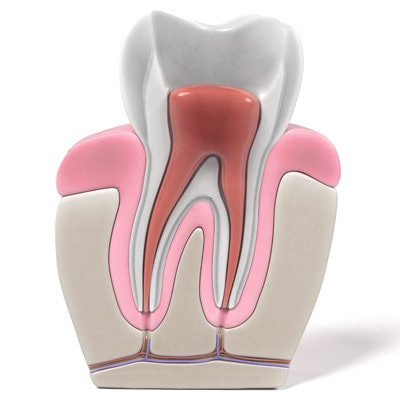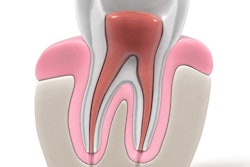
New research on pain control and management for patients was presented on April 11 at the 2019 American Association of Endodontists (AAE19) annual meeting in Montreal. The presentations included research on the use of photodynamic therapy, persistent pain after root end surgery, and the link between depression and postoperative pain.
Photodynamic therapy
In the first poster presentation, researchers in private practice and from the University of North Carolina at Chapel Hill School of Dentistry and the São Leopoldo Mandic School of Medicine and Dentistry in São Paulo, Brazil, assessed the effects of photodynamic therapy (PDT) on postoperative pain in 12 patients with necrotic pulps and symptomatic apical periodontitis.
The researchers recorded patients' preoperative pain level on a visual analog scale ranging from 0 to 10. The patients were divided into two equal groups:
- The photodynamic group had their canals flooded with 1.56 µm/mL of methylene blue for two minutes and 660-nm laser applied using an optical fiber.
- The control group had only root canal instrumentation.
The patients registered their pain sensation and the number of ibuprofen tablets (600 mg) taken at 24-hour, 72-hour, and one-week intervals.
The mean preoperative pain reported was lower for the photodynamic group than the control group (7.66 ± 3.01 compared with 10). Both groups noted pain relief after the procedure (see table below).
| Pain relief as reported on a visual analog scale | ||
| Time after procedure | Control group | Photodynamic group |
| 24 hours | 3.5 ± 3.14 | 0.33 ± 0.81 |
| 72 hours | 1.0 ± 1.67 | 0 |
| 1 week | 0.16 ± 0.40 | 0 |
Patients in the photodynamic group also reported taking fewer pain relief tablets than those in the control group (0.33 ± 0.51 compared with 1.33 ± 1.03).
However, the researchers found no statistically significant difference between the groups (p > 0.05) and concluded that photodynamic therapy had no statistical effect on postoperative pain in these patients.
Persistent pain
While up to 11% of patients experience persistent pain after nonsurgical root canal treatment, researchers from Harvard School of Dental Medicine in Boston and the New York University College of Dentistry in New York City wanted to discover the frequency of persistent pain after root end surgery. In a poster presentation, they reported their interim analysis of an ongoing study that includes 56 root end surgery patients.
Demographic, dental and medical history, and well-established risk factors of persistent pain were recorded before the procedure. Postoperative pain was measured for six months.
The researchers reported that 15 of the patients experienced pain within the first month after surgery. The number of patients experiencing pain in the second month after surgery dropped to 10. Five patients reported pain at the six-month follow-up.
Persistent and subacute pain occurred more frequently than expected after root end surgery, the researchers concluded.
Depression and dental pain
Managing dental pain in patients who are also clinically depressed may be challenging. Researchers from the University of Maryland School of Dentistry in Baltimore presented preliminary results of a study exploring the link between the severity of depression and the pain intensity associated with a nonsurgical root canal treatment.
The researchers used the Hospital Anxiety and Depression Scale (HADS) to calculate depression or anxiety in 20 patients using individual pain diaries to record pre- and postoperative pain/unpleasantness.
They found a statistically significant positive correlation between second-day postoperative pain and HADS score. However, at four and seven days after the procedure, HADS score and pain level were not correlated (p > 0.05), they reported.
The researchers concluded that a significant positive correlation was found between depression/anxiety score and postoperative pain.


















